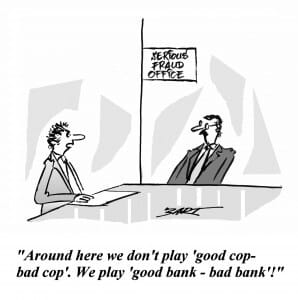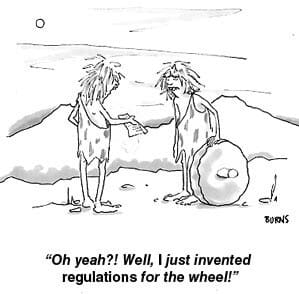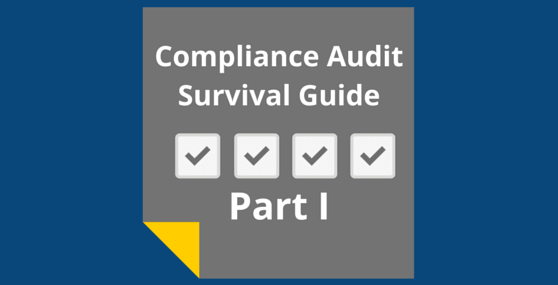NOTE TO READERS: Regulatory compliance is top of mind for financial institutions in this era of strict oversight, and all types of bank underwriting are affected, including the appraisal function. To help you do everything you can to prepare for the scrutiny of examiners, EDR® Insight is fortunate to have Mitch Kreeger, MAI SRA MBA, as a guest author for this two-part series on surviving an appraisal compliance audit. Kreeger is an appraisal, environmental and seismic risk consultant and reviewer who has worked extensively with lenders and independently for over 25 years. Part 1 of our series focuses on the specific things that bank examiners are looking for in an appraisal compliance audit and the cost of non-compliance. Part 2 will provide specific best practices for banks to include in their appraisal policies to protect them from themselves when markets heat up.
In the US institutional lending industry, it is a given that regulatory compliance exams or audits will occur. One facet involves appraisal related activities. Who are the examiners? What are they looking for? What is the cost of non-compliance? What are the best prep and response options for a financial institution? This article explores these issues in two parts, and offers a few survival tips. It is based on numerous discussions and interviews with regulators and industry peers, as well as my 25-plus years of experience inside and as outside consultant for various large and small lending institutions.

Regulators used to be perceived as “Bad Cop”, instilling fear among lenders that talking to these examiners may initiate criticism of the bank’s processes or loan files. The fear was that the “Bad Cop” would either find something wrong at the “Bad Bank” or “hit the tail lights” to dig deeper in search of criticizable items. Until the past decade or so, regulators were less visible and less proactive in their approach to guidance (more “stick” than “carrot”) so they were not well regarded.
Times have changed and regulatory examiners are emerging as “Good Cop,” encouraging lenders to seek them out for advice or interpretation of regulatory guidance toward the goal of realizing “Good Bank” status. Albeit often purposefully vague to not be perceived as managing your business or limiting your competitiveness, examiners do typically respond to actual or hypothetical questions and will share common findings and best practice tips. CAUTIONARY NOTE: Examiners will closely review high-risk practices and may impose requirements if Safety and Soundness are in question.
WHAT ARE EXAMINERS LOOKING FOR?
Compliance examinations review an institution’s operating practices for Safety and Soundness “red flags” (i.e., higher risk banking practices relating to Operations, CRA, Lending, Credit, and Compliance). ANYTHING that puts depositors or taxpayers at risk is fair game. Frequency of successive exams depends on audit findings.
Bank policies are NOT one-size-fits-all and can vary significantly from one bank to another. Regulatory supervisory direction points to softer guidance and enforcement for small banks of less than $1 billion in asset size. Examiners will closely review bank policies for adequate regulatory compliance as well as appropriateness to the institution per Interagency Appraisal & Evaluation Guidelines (IA&EG 2010).
Current guidance dictates that a bank’s appraisal function MUST BE INDEPENDENT of loan production, credit and collection processes at larger banks, and as independent as practically possible at smaller or rural institutions. Small or rural institutions should therefore enact safeguards to isolate collateral valuation from influence or interference from loan production. Studies indicate that the vast amount of bank failures were in the smaller bank category (FDIC OIG, Report to the Congress: Comprehensive Study on the Impact of the Failure of Insured Depository Institutions Report No. EVAL-13-002, January 2013).
Examiners will review steps taken by an institution to ensure that persons who perform the institution’s appraisals, evaluations, and environmental reports are qualified, competent, and not subject to conflicts of interest.
“An institution’s real estate appraisal and evaluation policies and procedures will be reviewed as part of the examination of the institution’s overall real estate-related activities. Examiners will consider the size and nature of an institution’s real estate-related activities when assessing the appropriateness of its program.”
~Interagency Appraisal & Evaluation Guidelines, 2010
For any institution, the keys to risk mitigation center on adequate loan structuring, managing risk exposures, and applying “As Is” value to all Federally-Related Transactions (FRTs). Risk exposure is the deciding factor between long-term financial soundness and the ability to withstand economic downturns or cycles versus unsound institutions that are less likely to withstand a downturn.

COSTS OF NON-COMPLIANCE – RANGE OF EXAMPLES
“[Non-compliance with] agencies’ appraisal regulations or to maintain a sound appraisal and evaluation program consistent with supervisory guidance will be cited in supervisory letters or examination reports and may be criticized for unsafe and unsound banking practices. Deficiencies will require appropriate corrective action.”
~Interagency Appraisal & Evaluation Guidelines, 2010
Failure to comply or insufficient compliance with Agencies’ supervisory guidance will be criticized and/or penalized depending on the level of impact to safety and soundness. Below are a few real-life examples of lenders who were charged with non-compliance for various reasons.
A recent article, “Citigroup Settles Mortgage Probe, Pays Record Penalty” (Appraisal Institute, Appraisal News Online, July 16, 2014), identified actual criticism of a bank from a recent U.S. Department of Justice civil fraud case. The DOJ claimed that: “Despite Citigroup learning of serious and widespread defects among the increasingly risky loans they were securitizing, the bank and its employees concealed these defects” (USAG Holder; Reuters; AI ANO). Citi knew “significant percentages” of securitized loans did not comply with their underwriting guidelines, but pooled and sold them anyway. PENALTY: $7 Billion. It is worth noting that this is the largest civil fraud penalty ever levied by US DOJ: “Penalty is appropriate, given the strength of the evidence of the wrongdoing by Citi.” (USAG Holder; Reuters; AI ANO)
In a milder lender criticism, upon a Federal Reserve Board exam, a bank was told that Broker Price Opinions (BPOs) ordered by loan production personnel for loan monitoring were unacceptable – the bank did not follow an acceptable process. The FRB indicated that BPOs are acceptable with some restrictions including independence from loan production as was the exam’s concern. There was no penalty upon initial criticism, but the FRB required the institution to fix the problem, and avoid repeating it by their next audit.
A recent report noted that “75% of now-failed banks had been previously cited for various appraisal violations, often failing to obtain appraisals where required, or having insufficient resources within the bank to manage and oversee the appraisal function” (AI Material Loss Reports, Appraisal Oversight: The Regulatory Impact on Consumers and Business, June 28, 2012). A bank failure is defined as “the closing of a bank by a federal or state banking regulatory agency” (GAO). Most common violations cited were:
– failure to obtain required appraisal/evaluation;
– failure to achieve minimum appraisal standards; and
– failure to obtain appraiser with required independence or competency (FDIC OIG, Report to the Congress: Comprehensive Study on the Impact of the Failure of Insured Depository Institutions Report No. EVAL-13-002, January 2013).
Ineffective appraisal, review and collateral risk programs contribute to, and amplify, losses. Fortunately, there are steps that banks can take to protect themselves.
*****
Part 2 of this series, which addresses “best practices” and tips that you can use to survive an appraisal compliance audit at your institution, can be found here.
